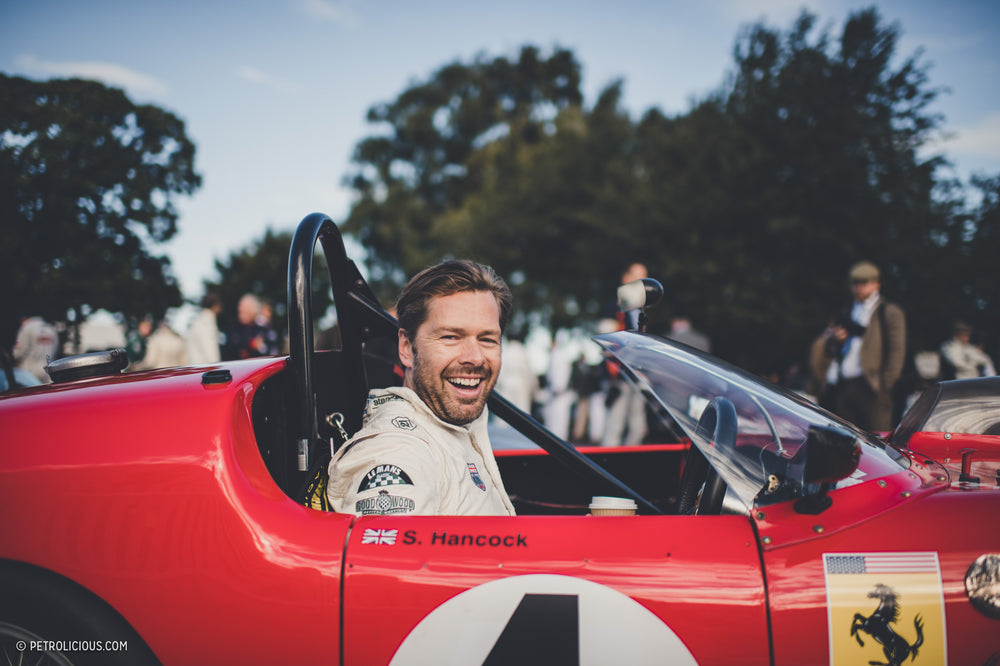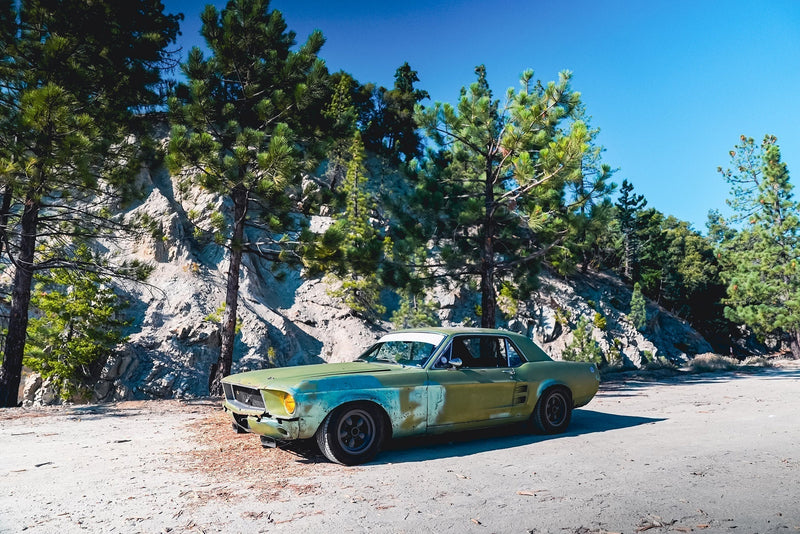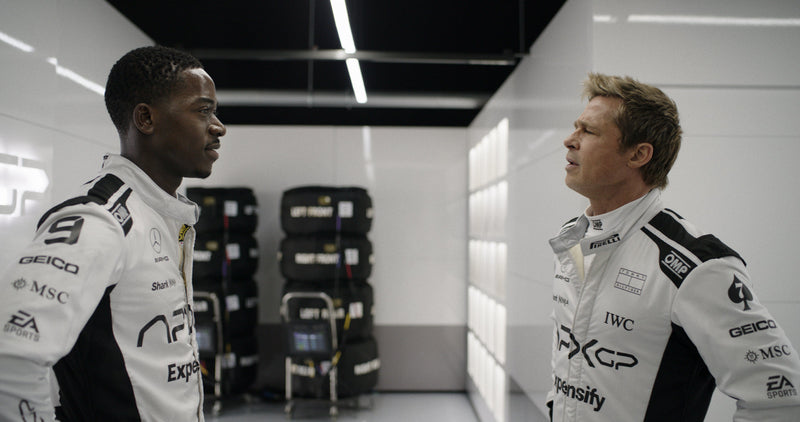The original lifespan of the Goodwood Circuit was from 1948 to 1966. And now that the Revival has been running since 1998, it is thus rather astonishing to note that the Circuit’s second life as a vintage racing venue has now outlasted its original period!
Does this mean Goodwood's gone full circle? Is racing now so (re)established here that its modern story is as great as the original one? There is one very obvious difference between now and then to note first: the post-war period saw enormous development of racing cars and arguably the fastest evolution of the racing car. From pre-war-designed single-seaters, to rear-engined monocoques, and from simple sports cars to mid-engined GTs, no other period has witnessed such development and indeed change in competitive speeds.
While the cars at the Revival are undoubtedly benefiting from modern custodianship, they still haven’t changed since 1998 (or indeed their original era), but what about the drivers? Apart from some of the old boys still racing (e.g. Derek Bell and Jackie Oliver), have the types of drivers changed in any material way? Close examination reveals a surprising similarity between the cross sections of those from “back in the day,” and those that pilot the same old machines at Goodwood now.



Really? Well, pretty much. Put simply, the drivers may come in all shapes and sizes and the average age of those competing at Goodwood is quite a lot higher than it was, but they tend to fall into three categories: Gentleman Drivers, Professionals, and the Young Guns. In their time, examples of these could be Graham Hill, Duncan Hamilton, and Stirling Moss.
There is a big difference in periods though, as the pros, gents and young guns of yesteryear were taking part in top-flight motorsport. The Revival is not top-flight motorsport in the conventional sense, but the event has done a great deal to foster historic racing to a level of huge public appeal. One might argue that historic motorsport is now its own form of high-level motorsport and has a support industry all of its own. Hence the pros and amateurs in the mix. Indeed, one race at the Revival, the St. Mary’s Trophy, had 90% pro drivers of today or the past on the grid. Not for nothing is the fact that the Revival’s scheduled in a way to avoid clashes with other major racing events in what I imagine is an attempt to attract the best talent to the circuit.
Last weekend I headed off for a damp Goodwood to follow three drivers competing today that I think fit the three profiles I’d mentioned earlier; the Gentleman, the Pro, and the Young Gun. These are their stories.
The Gentlemen Driver. Chris Wilson in the Whitsun Trophy Race, driving a Ford GT40
At one level, one might view the path of the urbane Chris Wilson as typical for an enthusiast. Inspired by a trip to the 24 Hours of Le Mans and excited by seeing racing at an early Revival as well, he remarks “I wondered how to get from a seat in the grandstand to a seat in a car. I really wanted to race at Goodwood.” Wilson’s interest and taste in cars was fueled from a very young age then by that journey to Le Mans and the following experience in England, and as a boy he worked weekends for fun in a garage near his home in Hampshire wrenching on various classics. Later he would continue to work on cars and even trade a few to help pay for his time at college.



The highly-focused Wilson embarked on a telecoms career co-founding a business that went on to enjoy great success before then moving to Australia for 10 years, before coming back to the UK. But the racing bug was never far away throughout this, and a few seasons with pro karts, tarmac rallies, and club racing in Australia further fueled the passion.
Chris is a man who feels eternally fortunate which is usually how humble people feel. Being able to acquire Ford GT40 Chassis 1018 in 2009 was a pinnacle moment in his life, as 1018 is an ex-Shelby American production race car which had a very quiet life in period as a Shelby promotional and test car, before starting its racing career in the UK in the early 1970s. Though it began competing later than most of its brethren, it did its due time and after some seasons in the UK it was sent to race in Australia before returning to the UK and eventually finding its way into the hands of three-time World Sports Car champion Ray Bellm, who embarked on a vast and varied campaign of contemporary historic events with 1018 over the ensuing years.
For Chris, driving this car is an almost overwhelmingly exciting experience, highlights of which include taking the Daytona banking at speed, and traveling along the Mulsanne Straight at Le Mans just shy of 200 mph. “It’s a very serious car, but wonderful to drive. A light touch is rewarded and the car feels very strong as well as fast. It’s one of the most original cars too, with an all-original chassis and the most fabulous provenance, it’s very special.”


For Chris, as he puts it: “To be able to race this car at Goodwood is incredible. This is my third Revival but Goodwood still enthralls me the way it always has. The setting is beautiful, the history and charisma of the place is unique, and then there is the track. Fast, flowing, and requiring great commitment.” After a year of coaching with Sam Hancock, he feels even more comfortable in the car and these lessons proved their worth last weekend with a superb 5th-place finish on the grid in treacherous qualifying conditions. “I am really pleased with that; the conditions favor the GT40s, but there are a lot of us on the grid and some very good drivers here too. Racing at Goodwood is full-on, and with more power than grip this car is demanding, but huge fun!”



I asked him about his expectation of the race result: “7th, I would be pleased with that.” The race started in very wet conditions but in glorious sunshine, and though it remained damp throughout the race despite the warmed tires passing continuously over the surface, Chris had a very good start, and got up to 4th for a while before other drivers found their (webbed) feet. Chris came home with a very impressive 6th, and those in front were highly experienced and some were pros. “I was very happy with the result. My times were very consistent, but a few others raised their game. I was pleased to see the checkered flag without any mishap in those conditions. I was beaten by pros and I beat some other pros, I could not have wished for a better result!”
The Professional. Sam Hancock in the Sussex Trophy Race, driving a Ferrari Dino 246S
A few years before Lewis Hamilton was cutting his teeth on karts, there was another aspiring star: Sam Hancock. At only 37 today (Hamilton is 32), Sam’s professional career has taken a turn that he would never have foreseen in his early days. A pro in historic cars? Surely not! But given that most hot-shots have seen their star dimmed long before the age of 37, it must be said that Sam’s career now signals if not a revival, then a renaissance.
He followed the well-trodden path of karts for seven years, followed by Formula Vauxhall Lotus and then onto Formula Palmer-Audi. A short stint in the US in the Barber single-seat series was followed by the altogether more serious Formula 3000 in the Jordan F1 “Junior team.” For fifteen years he has also been racing sports and GT cars at the international level and taken part in Le Mans seven times too. In 2004 he was the LMP2 Le Mans series champion, and he was a works Aston Martin driver in 2010 and 2011. The list goes on. Sam is the consummate modern pro driver, and in his spare time a coach of high repute, and in 2003 he took part in his first Goodwood Revival in a Lotus XI and has been active in historic cars ever since. He really made his mark in 2005 though when he drove Lord Bamford’s GT40 to victory and set a new outright record for Goodwood.



So with all that under his racing belt, does Sam think that Goodwood and its old cars is a serious enough discipline of the sport? “The racing here is fair and professional, but yes, it’s very tough. With these old cars there has to be a lot of understanding as to where the cars are in relation to each other since a 120mph drift with three cars abreast contains a degree of unpredictability. I really dislike contact, so the driving has to be very good here.” Though Sam has respect for fellow drivers and expects it in return, he reserves most of his respect for the track itself. “This is a uniquely authentic track, exactly as it was and with very fast corners, a wonderful rhythm to it but very little run off. If you leave the tarmac at Goodwood the chance of damage is high. All drivers need to ‘drive within themselves’ at Goodwood, respecting the track and the varying ability of other drivers. It’s demanding and it’s one of my favorite tracks anywhere in the world.”





Sam drove an E-Type at this year’s event, but he also drove the very rare and virtually priceless Ferrari 246 S Dino from 1960. In period this hallowed machine was raced by von Trips and Phil Hill, finishing 2nd in the 1960 Targa Florio. It went on to race with NART in America with the Rodriguez brothers as well, so to put it simply, chassis 0784 has quite the history behind it. It has a Formula 1-derived engine mounted amid its slippery bodywork, the combination of which help the little car achieve massive speed on the straights. Sam describes it as “Extraordinary, it has a great racing short-throw gearbox and lovely handling, but it requires a special type of commitment to get the best out of the car. You have to attack the corner entry and drive it on the throttle at all times. If you don’t, it will understeer and be significantly slower than its potential.”
In damp qualifying, Sam put the car on the second row of the grid for the Sussex Trophy race with the 4th fastest time in the group. “I was not very happy with 4th, and the car had slight misfires from all the water of the previous day, but to be just 6/10ths off the pole is pretty good all the same.”


The race on Sunday occurred during atrocious conditions even for England, and it got wetter as time passed. On his out lap it was apparent that he would need to choose between looking through the wet screen and visor, or looking over the screen for better visibility but less comfort. He chose the latter. Sam’s practice and knowledge of the track enabled him to make the best of the drier lines and he managed through the deluge to get up to second position by the end of a dramatic first lap. Bryant’s Lotus 15 was a formidable foe, but the Ferrari’s pace with more power and better brakes would help Sam take first place on the Lavant Straight and then establish a comfortable lead that he held until the final flag. “I rated this win very highly, not least because the car is so special and for a Ferrari to win in their 70th year with such an important car from their past.” Sam counts himself as fortunate to have the chance to be in such a machine, and is grateful to the Leventis family for their generosity. But clearly his professional quality has a lot to do with his good fortune.
The Young Gun. John Polson in the Brooklands Trophy Race, driving a 1934 Talbot
John would likely be surprised to hear himself called a “young gun,” but he is part of a growing coterie of drivers whose racing started and has stayed in historic cars. It is a relatively new trend, and he represents it well. Coming from a family that celebrates and uses mostly pre-war cars of competitive importance, it is perhaps no surprise that he should be “that very young guy in very old cars.”
At just 17, he started competing in hillclimbs in a 500cc JAP-engined single-seater, and half a decade later his circuit career started at the age of 22 in a pre-war Talbot. John, whose day job is as a specialist for Bonhams car auctions, is used to driving cars far older than he is. He has stretched this principle to the limit by racing an Edwardian 1912 Sunbeam, which is rather rudimentary and certainly very challenging because of it. And though he is definitively a vintage car competitor, John considers his racing exploits to be quite varied: “Actually the newest car I have ever raced is a 1960 Riley. I have raced with Vintage Sports Car Club and at the Goodwood Members’ meeting, but 2017 will be my first Goodwood Revival and the first time racing the 3.3-liter Talbot.”




The famous Talbot is a former works race and rally car, and in its period it had done an enormous amount of motorsport at Brooklands. This very car held numerous records at that venue, including 100 miles at 100mph, and an outer circuit four-seater record of 129mph average speed. It is perhaps best known for winning the grueling Alpine Cup in 1934 though. This then is a very important pre-war racing car and grand tourer of its day. Does this daunt Polson though? “It’s such a great car, I am conscious of its value and maybe hold back a little, but it's a very forgiving, stable, and strong car with very good rod and cable brakes and a very decent turn of speed. It’s not the lightest pre-war car here, but its engine propels it well. None the less, it's a very physical car to drive.” Whilst John is a young and yet seasoned historic driver, the owner of the Talbot Wilfried Schaefer is very happy to see the car put to its intended use.
Practice for the Brooklands Trophy race was held during the damp Friday sessions, and lap times were reflected in these slippery conditions. Skinny tires and heavy cars on a damp surface make for entertaining driving and viewing, that is for certain. And beyond that, the field did not disappoint in and of itself. John was suitably circumspect, but his 19th on the grid does not take into account how close the midfield times all were to each other. This was a tight pack. “I really enjoyed the practice, but the conditions demanded respect rather than heroics from me.”



In stark contrast, the race on Sunday morning was bathed in sunshine over a dry track. The finish order was therefore likely to be different to the starting grid, and that does not even take into account the less reliable nature of these old cars: 25% would fail to finish. John recalls: “I got a really good start and at one point in the race I was up to 10th. I had a great scrap with a Bentley and the Aston Martin Speed model that would finish 9th, but then the ignition developed a small fault and I lost some power. It was not a serious issue but it meant that I dropped to 14th. All the same, I am very happy with the result.”




















































